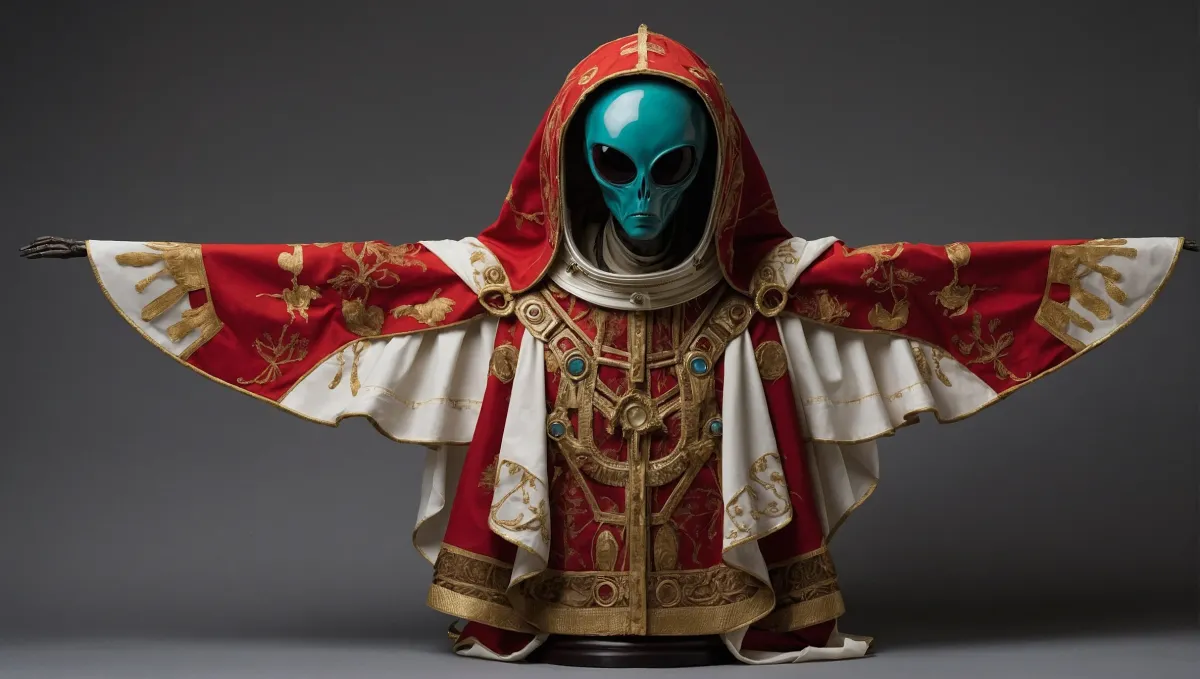The Alien Saint

Armand Fontana’s “The Sacerdote of Mars” offers a unique visual experience blending antiquity with the uncanny. Draped in vibrant red fabric adorned with intricate gold embroidery, the piece features an alien visage beneath a traditional ecclesiastical hood. Fontana, known for merging religious iconography with speculative fiction, creates works that challenge our conventional perceptions. This artifact, whispering tales from strange skies and forbidden rites, is an indispensable part of the Ravensfield Collection.
The inspiration for the piece comes from the ruins of Temura Valles on Mars, where an ancient structure was discovered beneath the ochre sands. An inscribed tablet depicting a humanoid figure with elongated limbs and bulbous eyes was unearthed, resembling descriptions found in Earth’s ancient mythologies. The artifact sparked numerous scientific debates. Fontana’s interest piqued when rumors spread about ghostly apparitions haunting the excavation site, leading to nightmarish visions among the researchers.
The tale surrounding “The Sacerdote of Mars” centers on Dr. Elias Wren, an archaeologist obsessed with Martian lore. During the expedition, Wren allegedly encountered an ethereal figure clad in robes like those in Fontana’s sculpture. According to his diary, the ghostly entity guided him through ceaseless paths beneath the Martian surface, revealing a hidden tome written in an undecipherable script. Obsessed and transformed by these nocturnal visits, Wren began chronicling strange, otherworldly symbols. His companions claimed they frequently found him conversing with invisible presences, eyes glazed as if peering beyond reality.
“It is as if I communicate with the ineffable,” Dr. Elias Wren wrote days before his disappearance.
As Wren’s behavior grew more erratic, reports of unsettling phenomena at the excavation site emerged: shadows moving without sources, phantom chanting echoing through rocks—signs lending credence to Wren’s belief in an ancient Martian priesthood still lingering beyond death. Then came the fateful night when Wren vanished entirely, leaving behind only his journal, opened to a cryptic drawing resembling Fontana’s artwork and the alien depiction on the Temura tablet.
Following Wren’s disappearance, crew members reported dreams of golden-red illusions twisting into uncannily familiar shapes suggesting warnings or prophecies unfathomable to the human mind. The excavation halted abruptly; scholars retreated, fearing further mental subjugation by whatever ancient specters lingered there.
Today, “The Sacerdote of Mars” stands not just as an art object but as a conduit for tales from celestial realms and arcane histories guarded by nonhuman priests eons before Earth had priests of its own. Viewers often recall feeling unwelcome hands grasping at their thoughts when standing too close for too long—a sensation allegedly shared by those affected at Temura Valles years ago.
Fontana’s creation epitomizes the delicate boundary where wonder interlaces with dread, leading to unspeakable revelations from some otherworldly dawn—a testament etched in sculpture form, binding us to enigmatic epochs beyond our comprehension.
In contemporary dialogues surrounding interstellar art forms and esoteric histories, “The Sacerdote of Mars” remains a pivotal exemplar, challenging sensory bounds while inviting pilgrims into an elder-universe communion inked within catacombs beyond time’s decay.




